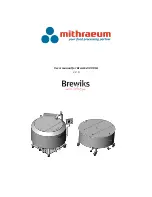
FOR TECHNICAL QUESTIONS, CALL (877)432-6627
19
•
KEEP HANDS AND FEET CLEAR of lift when operating.
•
Avoid pinch points.
5. Raise the lift half way until the lift arms are approximately 24
"
off the floor.
6. Loosen the bolts on the Arm Restraints. Adjust the Arm
Re-straints so the gears mesh firmly and smoothly. Tighten
the
Arm Restraint Bolts. Apply a small amount
white lithium
to the
gears. (See figure 22)
STEP 11
( BLEEDING )
1. With the lift in an elevated position, the hoses connected and
the oil reservoir full, loosen the bleeder screws located at the
top of each hydraulic cylinder using a allen wrench. Do not
completely remove the bleeder screws. Watch and listen as
trapped air escapes the cylinders and fluid beings to weep
from the screw area. Once steady fluid appears, re-tighten the
bleeder screw. (See figure 23)
The lift will move down when bleeding make sure all equipment,
personnel, hands and feet are clear before bleeding .
2. Press the power unit raise button until both cylinders reach
their full stroke. Do not continue pressing the raise button
after lift reaches full height damage to the motor and / or flow
divider can occur if continued.
3. Repeat the bleeding procedure.
4. Press the lowering handle inwards until the lift lowers completely to the floor. Repeat the above proce-
dure until the lift maintains level lifting and lowering.
DO NOT use lift if an unlevel lifting condition occurs at the arm pad locations that is greater than 3-de-
grees or 1.5
"
. If an unbalanced condition occurs, Follow the bleeding instructions shown on this page
or consult factory. The lift must be re-leveled, shimmed and bled each time the lift is reinstalled. Failure
to follow these instructions can result in serious injury or death.
POST INSTALLATION CHECK OFF
WARNING
Fig. 22
Fig. 23
Bleeder
Screw
DANGER
Columns are properly shimmed and stable
Anchor bolts are tightened
Pivot / sheave pins are properly attached
Electric power supply confirmed
Tie bar straps installed and bolts tight
Safety locks bars removed
Check for hydraulic leaks
Oil level
Lubcation of critical components
Check for overhead obstructions
Lift arms are level
Arm restraints properly adjusted
All screws, bolts, and pins are secured
Surrounng area is clean
Operation, maintenance and safety manuals on
site.
WARNING
Содержание maxjax
Страница 35: ......















































